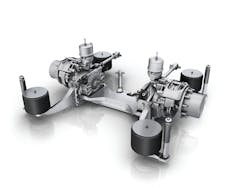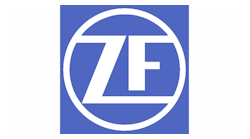With new gear geometry and even quieter running, ZF has further optimized the AVE 130 electric portal axle for usage in low-floor buses. The axle, which is ideal for several energy concepts such as all-electric mode or serial hybrid systems, has already proven its everyday suitability in field trials in several major European cities. For light coaches and intercity buses — a format increasingly being used in South America and Asia — ZF also offers a hybrid variant of the AS Tronic lite.
In several field trials, more than 300 electric portal axles have clocked up more than 10 million kilometers over the past few years, demonstrating the everyday suitability. Including in articulated buses manufactured by EvoBus, the AVE 130 is being used in serial hybrid operation together with a downsizing diesel generator.
A host of customer projects are undergoing testing or about to be implemented worldwide. Highlights include projects in China with the manufacturer Foton and in Turkey with the manufacturer Bozankaya where the AVE 130 is being used in battery-driven buses.
With a maximum axle load of 13 tons and a motor peak output of 2x120 kilowatts, the low-floor axle is even suitable for double-articulated buses. Here, two AVE 130 can be used in response to difficult topography so that the traction characteristics can be substantially improved. The wheels are driven individually via water-cooled asynchronous motors with a high power density and a subsequent fixed two-step ratio. Up to the maximum road speed, the passengers do not notice any tractive force interruption thanks to the absence of any gear changes. The serial hybrid operation together with the low-loss electric drive of the AVE 130 facilitate, with an optimum system configuration, fuel savings of up to 30 percent in driving operation compared with conventional diesel drives.
Installation-Compatible Low-Floor Technology
The AVE 130 is not only an innovation in public transportation in terms of energy efficiency. Other advantages arise in the case of optimum vehicle design because the AVE 130 is installation-compatible with ZF's well-known AV 132 and AVN 132 portal axles and its lightweight drive motors are directly located in the hub units of the axle. As the drive and propshaft in the rear are no longer needed, the installation space for seats and standing room can be expanded, the passenger area has a completely level aisle, and the low-floor technology provides for a step-less entry and exit. The AVE 130 also yields significant weight advantages thanks to its two integrated electric motors. It weighs 200 to 500 kg less than all other solutions with electric central motor, intermediate transmission, and conventional driven axle as well as solutions with gearless wheel-hub motors.
With the AVE 130, the ZF engineers developed an innovative city bus axle which has been designed for the most stringent requirements. A great deal of importance was attached to ensuring that the AVE 130 can be used in conjunction with normal tire/wheel combinations. Furthermore, easily accessible disc brakes were applied, which are also used in the conventional ZF bus axles.
The future might also see applications where the axle in articulated buses supports diesel drivelines or applications which can react flexibly to alternative track widths thanks to the simple construction of the axle bridge. On the same note, the focus will remain on the combination with alternative energy concepts, e.g. trolley lines, energy accumulators or fuel cells.
HyTronic: AS Tronic Lite Hybrid Version
Automatic transmission systems in the ZF AS Tronic lite model range are already being used in light intercity buses and coaches in South America and China. ZF is now also developing a hybrid version of this transmission for these markets.
This modular hybrid transmission can be integrated into the existing driveline. The overall system consists of transmission, 60 kW electric motor, inverter, power routing and energy management. Thus, it can assume all functions of a full hybrid system — the start/stop function, regeneration of braking energy (recuperation), support during acceleration (boost function), electric starting and all-electric mode.




